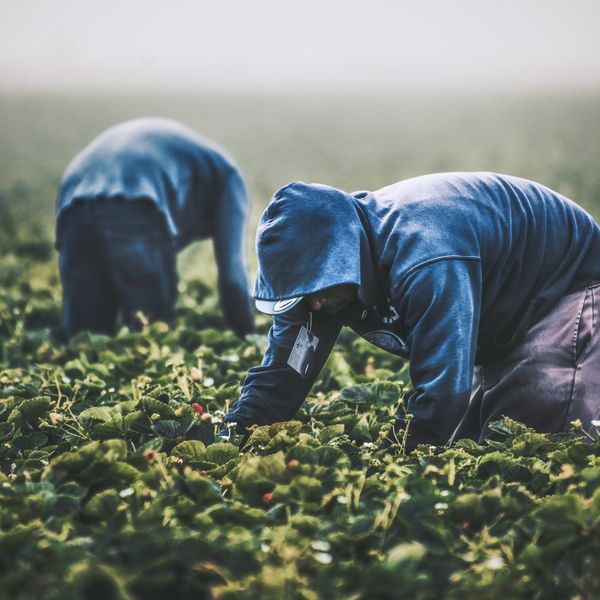Sometimes the truth about our food is not very appetizing.
As many gather this holiday season for shared family meals, it is likely that they'll be serving up small doses of pesticides with each plate passed, including a prevalent type shown to be harmful to children and reproductive health.
New data released recently by the Food and Drug Administration (FDA) shows a rise in the occurrence of pesticide residues detected in thousands of samples of commonly consumed foods. Documents obtained from the agency through Freedom of Information Act (FOIA) requests also show the government is bracing for more, with the use of at least one controversial weed killing chemical – the herbicide known as 2,4-D - expected to triple in the next year.
And buried deep within the FDA's latest annual pesticide residue report is data showing that a controversial insecticide called chlorpyrifos, which is marketed by Dow Chemical and is banned from household use due to known dangers, was the fourth-most prevalent pesticide found in foods out of 207 pesticides detected.
Overall, about 50 percent of domestic food and 43 percent of imported foods sampled showed pesticide residues in the FDA's testing for fiscal year 2015, which is the period covered in the new report. That is up from about 37 percent of domestic and 28 percent of imported foods found with residues in 2010, and up from 38.5 percent and 39 percent, respectively, found by FDA a decade earlier in 2005.
FDA sampling has been shrinking over the years, dropping about 25 percent from a decade ago from more than 7,900 samples to 5,989 samples tested in its latest report. The U.S. Department of Agriculture also does annual pesticide residue testing, but looks at more than 10,000 samples. The latest USDA residue report, which also was for the 2015 time period, found about 85 percent of samples contained pesticide residues.
Notably, samples of fruits and vegetables – considered healthy food choices – showed the highest frequency of pesticide residues in the new FDA report. Roughly 82 percent of domestic American fruits and 62 percent of domestic vegetables carried residues of weed killers, insecticides and other pesticides commonly used by farmers.
Among the domestic food samples, FDA said 97 percent of apples, 83 percent of grapes, 60 percent of tomatoes, 57 percent of mushrooms and 53 percent of plums carried residues. Exactly half of the fruit jams and jellies and similar spreads examined were tainted with pesticides, according to the FDA data.
Looking at imported fruits and vegetables, the FDA found that roughly 51 percent of imported fruits and 47 percent of imported vegetables carried residues. Overall, the imported foods had more illegally high levels of pesticide residues than did domestic foods sampled. More than 9 percent of both imported fruits and vegetables were considered in violation of legal pesticide residue limits compared to only 2.2 percent of American-grown fruits and 3.8 percent of domestic vegetables.
The FDA said some specific commodities brought into the country may warrant special attention due to illegally high levels of pesticides, including cabbage, mushrooms, oranges and orange juice and rice.
Outdated “safe” levels
The Environmental Protection Agency sets legal limits, referred to as "maximum residue limits" (MRLs) for pesticide residues on foods. The FDA and USDA routinely assure consumers that if residues are below the established MRLs, they are both legal and safe. But many scientists and medical professionals disagree, saying regulatory methods are outdated and too dependent on input from the chemical industry players selling the pesticides.
"Risk assessment practices at federal agencies have not been updated for modern scientific principles, including accounting for the fact that people are exposed to multiple chemicals and that certain groups, such as genetically susceptible, the very young and old can be at greater risk of exposure," said Tracey Woodruff, a former EPA senior scientist who directs the Program on Reproductive Health and the Environment at the University of California San Francisco School of Medicine.
The controversy around chlorpyrifos underscores those concerns. Farmers have been using chlorpyrifos since 1965 and the government has long maintained that as long as residues are below established MRLs, they are safe.
The insecticide is used on various types of California fruit, nut and vegetable crops that amount to more than 1 million pounds.https://t.co/ohArJ3Q6sM
— Salinas Californian (@salnews) December 16, 2017
But in recent years, that regulatory view has shifted as studies show that this pesticide, which is used on corn and fruits and vegetables such as cranberries, Brussels sprouts, and broccoli, can have harmful neurodevelopmental effects on fetuses whose mothers are exposed and on young children. Research ties the chemical to attention deficit problems, tremors, and autism.
On December 15, California's Office of Environmental Health Hazard Assessment listed chlorpyrifos as known to "cause reproductive toxicity." And the EPA has said that it can no longer vouch for the safety of the residues found in food. The EPA had planned to outlaw chlorpyrifos use in agriculture. But the Trump administration reversed that plan earlier this year after heavy lobbying from Dow and other agrochemical industry representatives.
The FDA declined to comment about its report and declined to address questions about the safety of chlorpyrifos residues found in food.
Surge in 2,4-D expected
Separate from the FDA's published residue report, internal FDA documents show the agency working to get a handle on the residues of two widely used herbicides - glyphosate and 2,4-Dichlorophenoxyacetic acid (2,4-D). An internal memo dated in May of this year obtained through FOIA states that 2,4-D use is "expected to triple in the coming year" because of new genetically engineered crops designed to tolerate direct application of the herbicide.
Neither FDA nor USDA has routinely tested for glyphosate despite the fact it is the world's most widely used herbicide, and testing by academics, consumer groups and other countries has shown residues of the weed killer in food. The FDA said in early 2016 that it planned to start testing for the weed killer, and documents show that one FDA chemist reported finding residues in honey and in oatmeal products, but overall results of the program testing have not been released publicly.
Details of the testing program are being kept secret, and in the documents released by FDA through the FOIA, large blocks of information are blacked out. FDA declined to comment about the status of the glyphosate and 2,4-D testing, including when it might publish some results
Pesticides that the FDA did test for, and find, in the latest food sampling report, included endosulfan, an insecticide that has been banned in more than 80 countries and is being phased out due to established dangers to human health; the insecticide DDT, which was banned in the 1970s in the United States, and malathion, an insecticide classified by the International Agency for Research on Cancer as probably carcinogenic.
Carey Gillam is a veteran journalist and research director for U.S. Right to Know, a non-profit consumer education group.


























